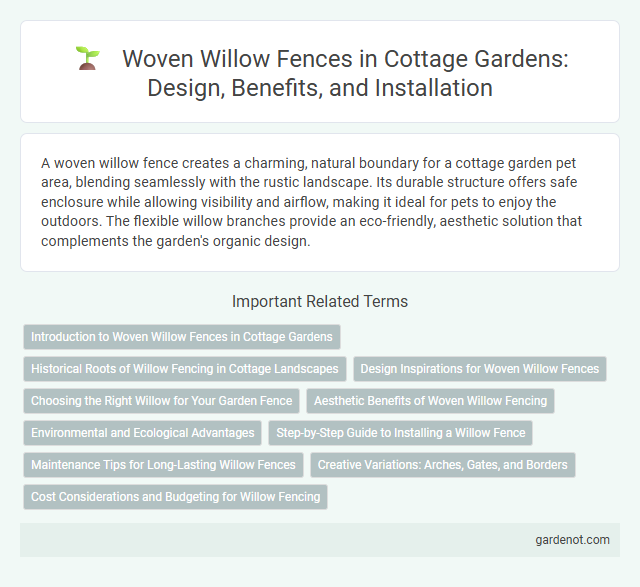A woven willow fence creates a charming, natural boundary for a cottage garden pet area, blending seamlessly with the rustic landscape. Its durable structure offers safe enclosure while allowing visibility and airflow, making it ideal for pets to enjoy the outdoors. The flexible willow branches provide an eco-friendly, aesthetic solution that complements the garden's organic design.
Introduction to Woven Willow Fences in Cottage Gardens
Woven willow fences bring a natural, rustic charm to cottage gardens, providing both privacy and an eco-friendly boundary. Crafted from flexible willow branches, these fences offer durability while blending seamlessly with lush greenery and vibrant floral arrangements. Their breathable structure supports garden ventilation and allows sunlight to filter through, enhancing plant growth and garden aesthetics.
Historical Roots of Willow Fencing in Cottage Landscapes
Woven willow fencing traces its historical roots to traditional cottage gardens, where local communities used flexible willow branches to create practical and sustainable boundaries. This ancient craft provided natural, breathable barriers that complemented the informal, rustic beauty of cottage landscapes while supporting biodiversity. The enduring appeal of willow fencing lies in its eco-friendly materials and the timeless aesthetic that reflects centuries of rural gardening heritage.
Design Inspirations for Woven Willow Fences
Woven willow fences draw inspiration from traditional rural craftsmanship, combining natural aesthetics with functional garden boundaries that enhance the organic charm of cottage gardens. Their intricate, handwoven patterns create a textured backdrop that complements lush, informal plantings such as lavender, roses, and foxgloves. The use of sustainable willow materials aligns with eco-friendly gardening trends, promoting biodiversity while offering a flexible, durable alternative to conventional fencing.
Choosing the Right Willow for Your Garden Fence
Selecting the ideal willow for a woven willow fence involves prioritizing willow species with flexible, durable stems such as Salix viminalis or Salix purpurea, which are favored for their pliability and strength. Harvesting willow rods at the right time, typically in late winter or early spring, ensures optimal flexibility and longevity in garden fences. Incorporating sustainably sourced willow enhances the natural aesthetic and ecological benefits of a cottage garden fence, promoting habitat diversity and soil health.
Aesthetic Benefits of Woven Willow Fencing
Woven willow fencing enhances a cottage garden's natural charm by providing a rustic, handcrafted look that blends seamlessly with floral and greenery elements. Its flexible, organic materials create an inviting texture that complements traditional garden designs and introduces visual warmth. The subtle curves and irregular patterns of woven willow add depth and artistry, elevating the garden's overall aesthetic appeal.
Environmental and Ecological Advantages
Woven willow fences offer sustainable garden boundaries by using renewable willow branches that decompose naturally, reducing environmental impact. These fences promote biodiversity by providing shelter and nesting sites for wildlife, including birds and beneficial insects. The porous structure of a woven willow fence supports healthy airflow and soil moisture retention, enhancing the overall ecological balance of a cottage garden.
Step-by-Step Guide to Installing a Willow Fence
Installing a woven willow fence begins with selecting flexible, freshly cut willow rods and preparing sturdy wooden stakes spaced evenly along your garden border. Drive the stakes firmly into the ground to create a supportive frame, then weave the willow rods alternately in and out around the stakes, ensuring tight and even spacing for durability and aesthetic appeal. Secure the ends of the rods by trimming excess and tucking them into the weave or fastening with garden twine to maintain the fence's structure over time.
Maintenance Tips for Long-Lasting Willow Fences
Woven willow fences require regular maintenance to remain durable and visually appealing in cottage gardens. Applying a protective sealant annually prevents moisture damage and prolongs the life of the willow branches. Periodic inspections to remove broken or loose rods and trimming surrounding vegetation help maintain structural integrity and airflow.
Creative Variations: Arches, Gates, and Borders
Woven willow fences in cottage gardens offer creative variations such as graceful arches that frame pathways, charming gates that enhance rustic appeal, and natural borders that define garden beds with organic texture. These structures blend traditional craftsmanship with flexible design, allowing customization to suit diverse garden layouts and enhance aesthetic harmony. Using sustainably harvested willow, these features provide eco-friendly boundary solutions that support wildlife habitats and seasonal greenery.
Cost Considerations and Budgeting for Willow Fencing
Woven willow fences typically cost between $15 to $40 per linear foot, making them a budget-friendly option for cottage garden enclosures. Pricing varies based on willow quality, fence height, and labor required for installation. Factoring in seasonal availability of willow and potential maintenance costs can help in accurate budgeting for a durable and aesthetically pleasing fence.
Woven willow fence Infographic

 gardenot.com
gardenot.com